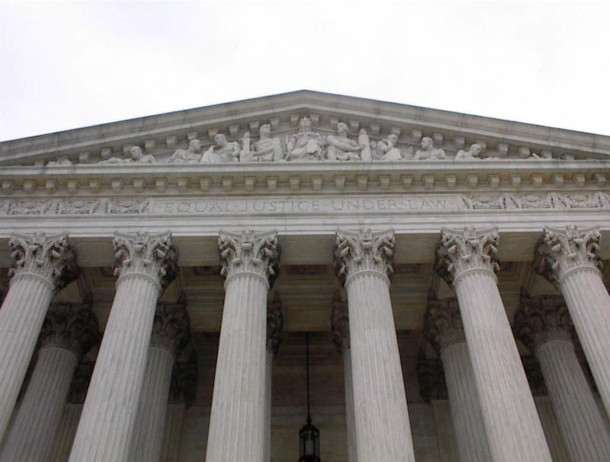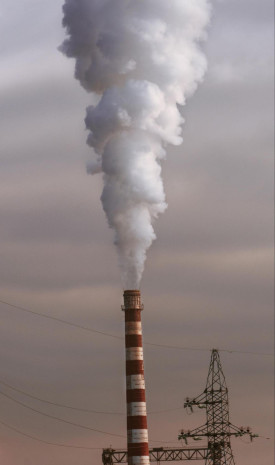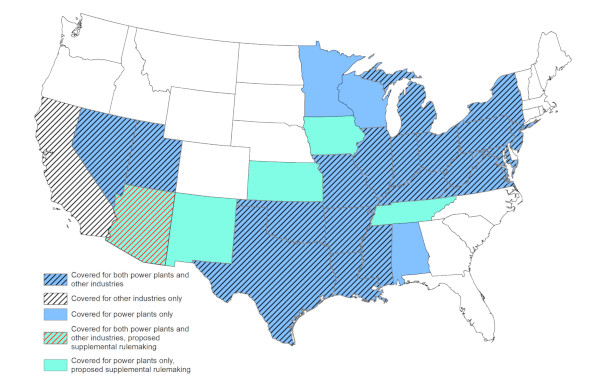States Challenge EPA "Good Neighbor" Rule
Air Date: Week of March 1, 2024

The U.S. Supreme Court heard oral arguments regarding the EPA’s “good neighbor” ozone rule on February 21, 2024. This was part of the Court’s “shadow docket”, as it was filed as an emergency appeal. (Photo: Wikiwopbop, Wikimedia Commons, CC BY-SA 2.5)
Ohio, Indiana, and West Virginia have challenged the Environmental Protection Agency’s “Good Neighbor” rule in the Supreme Court. The regulation is designed to keep one state’s ozone emissions from spilling downwind and pushing another state out of compliance. Michael Burger from the Sabin Center for Climate Change Law at Columbia University joins Host Paloma Beltran to explore what this challenge means for the environmental regulation landscape.
Transcript
O’NEILL: From PRX and the Jennifer and Ted Stanley Studios at the University of Massachusetts, Boston this is Living on Earth. I’m Aynsley O’Neill.
BELTRAN: And I’m Paloma Beltran.
Three energy producing states are arguing the EPA should be blocked from implementing an anti-pollution rule before the courts have a chance to rule on it, and in what would be a largely unprecedented ruling, the US Supreme Court appears poised to go along. On February 21st the high Court held oral arguments on an update of the EPA's so-called “Good Neighbor” rule that would tighten up measures designed to keep toxic smog in one state from pushing another state out of compliance. Regulations are often challenged in court, but the Supreme Court rarely handles them on an emergency basis. Ground-level ozone, also known as smog, is tied to a variety of health issues including increased respiratory illnesses, reproductive concerns, and cancers. But 115 million Americans now live in states where smog exposure exceeds legal limits--with the bad air often coming from upwind jurisdictions. So, the EPA’s “good neighbor” plan includes a failsafe measure – if these “upwind” states submit ozone emissions plans that are not up to snuff, then the EPA is required to step in. But last year, after EPA rejected the proposals of 23 states and created a federal enforcement plan, three states and a number of industry and trade groups challenged it, though it would be years before the most important parts of the measures would go into effect. As this case progresses, experts are noting comparisons to the 2022 case West Virginia vs. EPA, where the Supreme court preempted the agency’s options for regulating power plant emissions. Joining us now for more is Michael Burger, Executive Director of the Sabin Center for Climate Change Law at Columbia University. Michael, welcome back to Living on Earth!
BURGER: Thanks. It's great to be back.
BELTRAN: So this case was brought forward by three states, Ohio, Indiana and West Virginia, along with several companies and industry groups as an emergency action. What's their argument here? And how common is this sort of petition at the Supreme Court level?

Emissions from factories are one of the pollution sources addressed by the EPA’s Good Neighbor plan, which is up for review by the Supreme Court. (Photo: Grigoriy, Pexels, CC)
BURGER: Well, it is important to note that they brought it as an emergency action. So we're not dealing with your typical case that's before the Supreme Court that's been fully briefed by the parties, and where the merits of the case itself are what's before the court. What's before the court here is a motion to stay the federal rule while the litigation happens at the court of appeals below. And the argument that the states are making here is that because they will incur costs in the short term, in order to start to begin to come into compliance with the requirements that the rule sets forth, a couple of years down the line, the rules should be stayed while they're able to litigate the merits. And this type of argument is frequently raised by entities that are newly subject to regulation by regulated industries, and by states that are opposed to new regulations. What's different here is that the Supreme Court appears to be seriously considering staying the rule, even when the court below, when the DC Circuit Court of Appeals denied the very same motion.
BELTRAN: And, Michael, from what I understand, this isn't the only case that's dealing with the “Good Neighbor” plan.
BURGER: That's correct. There are a number of cases in different courts of appeals. Some of the cases are challenging EPA's rejection of the state plans. And then this case is challenging the EPA's plan itself. So you know, the outcome of this case will affect the other cases, but it's a little bit messy, what's going on in the lower courts. And we'll just have to wait and see what happens.
BELTRAN: And to what extent do you see this challenge in the courts as a parallel to the West Virginia vs. EPA case from 2022?
BURGER: In some ways, it strikes me as the Clean Power Plan 2.0. I mean, in that case, the Supreme Court, Justice Scalia reached down and stayed the Clean Power Plan while litigation was happening below. And that was really the first time that the Supreme Court had taken that kind of action. And here, there seems to be the risk that we'll see a repeat.
BELTRAN: So if the Supreme Court does sign against the EPA rule here, what's next?
BURGER: If the Supreme Court rules against EPA here, it won't be ruling against the rule per se. What they'll be determining is whether the rule should be stayed from going into effect or whether it should be enjoined from going into effect while the merits of the rule, the legality of the rule is litigated in the DC Circuit Court of Appeals. So you know, EPA's arguing here that that should not happen that well established precedent requires a very high bar for petitioners to satisfy and that here, the simple fact that they have to come into compliance or begin to come into compliance with the requirements is just not enough. If you think about it, that argument would apply in pretty much any circumstance in which a new federal rule comes into effect. Any party subject to new regulation could argue that it is going to incur some costs, while it challenges the rule. And we could find ourselves in a situation where pretty much most or even all major federal regulatory actions are put on hold while the courts figure out whether or not the courts are satisfied that they're legal. So here, if the rule is stayed, then the existing rules would remain in effect, and EPA would be somewhat stymied by the courts in its efforts to clean up the air and promote human health.

Because pollution easily travels across state lines, “downwind states” need the good neighbor rule to meet federal ozone standards, so they aren’t affected by the “upwind” states’ behavior. Shown here is the EPA’s graphic titled “States Covered Under the Final Good Neighbor Plan and the Proposed Supplemental Rulemaking”. (Photo: Environmental Protection Agency)
BELTRAN: And in the meantime, the states would still keep the ozone emissions before the update on this “Good Neighbor” plan.
BURGER: Right, it's not a "Wild West" situation. There are standards in place, and there are plans in place for compliance with the “Good Neighbor” provision of the Clean Air Act, and those rules would continue to apply, even if this one gets held up.
BELTRAN: Michael, why does this case matter?
BURGER: Because we're before the court here on an emergency action. What's at stake here is less the ultimate outcome of the case, where the challenge to the EPA's “Good Neighbor” plan, and more kind of how the court and the courts are going to operate in relationship to new federal rules and new federal regulations. The real risk here is that if the court enjoins this rule from going into effect, just because regulated entities incur costs, in order to start to come into compliance with the terms of the rule, that argument could apply in pretty much any circumstance. And so we might well find ourselves in a situation where federal agencies are really held back in their ability to provide environmental and public health and consumer protections, while litigants challenge things in court.
BELTRAN: Well, Michael, we can't really predict what will happen. But let's look into your crystal ball. How do you think this case might impact how the Supreme Court behaves in the future?
BURGER: If the Supreme Court does decide to enjoin the rule at this stage, it would be a unusual move. You know, it's not the usual trajectory for litigation in the federal courts to get to the Supreme Court and to have a major federal rule like this, you know, stopped, while it gets litigated in the courts below. The law has developed over half a century or more to sort of protect against that, precisely because we do not want our government to be held up every time it tries to pass a new regulation, forced to wait for the courts to determine whether or not what it has done is legal. That is the reverse of how we want our separation of powers to operate. So, you know, in this particular instance, we are looking at a situation where if the court goes the route that many observers feel it is likely to go, we'll be looking at another instance of this court taking highly unusual action for what appeared to be ideological or even political reasons.
BELTRAN: Now you spent your career working in the environmental and climate law world. How do you react to a challenge like this at the level of the Supreme Court?

Michael Burger is the Executive Director of the Sabin Center for Climate Change Law. (Photo: Columbia University)
BURGER: Well, I think consistent with other action that we're seeing in the Supreme Court, and in some of the courts of appeals, the risk here seems to be part and parcel of a broad-based attack on the so called administrative state, on the power of federal agencies to take significant action to address contemporary problems of public health, the environment and other matters. You know, the willingness of some justices to block federal action at a very early stage, even before the courts below have ruled on it, which is quite simply an unusual move in our court system, it's surprising. It's not absolutely surprising, because we have seen it before, but it doesn't bode well for the ability of federal government to address emerging and well established environmental and public health problems. And I should also say, we don't have a decision on this case yet, of course. You know, there is some tea leaf reading going on here based on what happened at the oral argument. So while it does seem likely that the court may well enjoin the EPA in this case, we don't know yet, that that's what's going to happen.
BELTRAN: To what extent do you worry about the future of environmental regulation in this country with so many rules being challenged in the courts? Where do you think we're headed?
BURGER: Well, I think that I like plenty of others, though not everyone, am quite concerned about the prospects for ambitious federal action under the current Supreme Court. And in the current state of the courts of appeals as well, at least in in certain courts of appeals, there does seem to be a ideological opposition to regulatory action by the federal government that is driving some of the doctrines that we are seeing emerging from the court and actions like this, emergency requests to stay new regulations from coming into effect, participate in this broader trend, which is using the courts and using the law to stifle regulatory action rather than to promote environmental protection. So if the court goes the wrong way here, I think it'll be a real cause for concern.
BELTRAN: Michael Burger is the Executive Director of the Sabin Center for Climate Change Law at Columbia University. Thanks for taking the time with us today.
BURGER: Thank you.
Links
Learn more about the EPA’s Good Neighbor plan
Living on Earth wants to hear from you!
Living on Earth
62 Calef Highway, Suite 212
Lee, NH 03861
Telephone: 617-287-4121
E-mail: comments@loe.org
Newsletter [Click here]
Donate to Living on Earth!
Living on Earth is an independent media program and relies entirely on contributions from listeners and institutions supporting public service. Please donate now to preserve an independent environmental voice.
NewsletterLiving on Earth offers a weekly delivery of the show's rundown to your mailbox. Sign up for our newsletter today!
 Sailors For The Sea: Be the change you want to sea.
Sailors For The Sea: Be the change you want to sea.
 The Grantham Foundation for the Protection of the Environment: Committed to protecting and improving the health of the global environment.
The Grantham Foundation for the Protection of the Environment: Committed to protecting and improving the health of the global environment.
 Contribute to Living on Earth and receive, as our gift to you, an archival print of one of Mark Seth Lender's extraordinary wildlife photographs. Follow the link to see Mark's current collection of photographs.
Contribute to Living on Earth and receive, as our gift to you, an archival print of one of Mark Seth Lender's extraordinary wildlife photographs. Follow the link to see Mark's current collection of photographs.
 Buy a signed copy of Mark Seth Lender's book Smeagull the Seagull & support Living on Earth
Buy a signed copy of Mark Seth Lender's book Smeagull the Seagull & support Living on Earth

